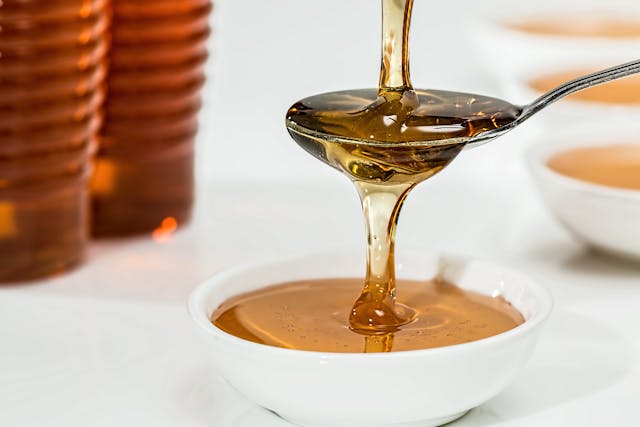
Why doesn’t honey spoil? Honey doesn’t spoil because it has almost no water in it, because it is a little acidic, and because it has antimicrobial compounds in it.
When food spoils, it is usually because microbes like bacteria or fungi start to feed on it. The only goal bacteria have is to reproduce themselves in order to pass on their DNA. They reproduce by a process called binary fission, where they split their cell and their DNA into two, then grow until they separate, to become 2 bacteria. Depending on the conditions and the type of bacteria, they can reproduce once every 5 to 20 minutes. However, they need a certain environment to be able to do this. The temperature has to be right. They reproduce best in the temperature range of 5 ℃ to 60 ℃. The environment can’t be too acidic or too alkaline. It takes a lot of energy for them to reproduce, so they need a food source. Many bacteria need oxygen, although some can produce energy without oxygen. These are called anaerobic bacteria and they can be used for fermentation. Bacteria also need water, which they use to fuel the chemical reactions that breaks down the food for energy.
If we want to keep food fresher for longer, we need to play around with the things that bacteria need to reproduce. We can lower or raise the temperature by freezing or cooking the food. The former immobilizes the bacteria and the latter kills them. We can make the food more acidic, such as by pickling it in vinegar. We can remove the oxygen by sealing it in a jar or vacuum packing the food. We can remove the water, either by drying or salting the food. All of these methods can stop food spoiling, but only for as long as the conditions are kept up. If frozen food defrosts, it will start to spoil.
Honey meets two of these conditions. Honey doesn’t have much water, and it is acidic. Why is that? It comes down to the way that bees make honey. Worker bees fly out from the hive to find flowers with nectar. The flowers produce nectar as a reward to encourage the bees to go in the flower and get covered in pollen, which they’ll carry to another flower. Nectar is made of proteins, some chemicals, but mostly water and sugar. The bees store the nectar in their honey stomach, which is separate to their actual stomach. Their honey stomach secretes enzymes which break the sugar in the nectar down into simple sugars: glucose and fructose. The worker bee flies back to the hive and regurgitates the nectar out of its honey stomach into the mouth of a house bee. The house bee will repeatedly regurgitate and swallow the nectar, mixing it with enzymes until nearly all of the sugar has been converted to glucose and fructose. The nectar is still mostly water here and the house bee will put the nectar into a honeycomb. The bees don’t know when they will use the nectar and they want it to last for a long time, so they remove most of the water from it. Several bees will fan the liquid nectar with their wings until almost all of the water has evaporated. The water content is less than 20% and the nectar has become honey. Then the bees will cap the honeycomb with beeswax and we will steal it.
That lack of water is the main reason why bacteria cannot grow on the honey. The water content of the honey is lower than that of the bacteria, and the bacteria will dehydrate. If you keep a jar of honey sealed and away from water, it will stay fresh for a very long time. If the top is open, moisture may settle and bacteria or mold can grow on the top of the honey, but the honey underneath is still dry and still perfectly fine.
The second reason is the acidity of the honey. When the enzymes from the bee convert the sugar in the nectar into glucose and fructose, the pH level of the nectar drops until it is about 4. That is about the same as tomato juice or acid rain. Bacteria tend to grow best at a pH level close to neutral, which is 7. The pH 4 of honey is too acidic for them to grow. In the conversion process, the enzymes also produce hydrogen peroxide, which is a mild bleach. It can kill bacteria. All of these things mean that as long as honey is left in a sealed jar without moisture, it can last for a long time. Honey from 5,500 years ago has been found and it is technically still fine to eat. I say “technically” because I don’t believe anyone has actually tried to eat it. And this is what I learned today.
Photo by Pixabay: https://www.pexels.com/photo/honey-on-white-bowl-33260/
Sources
https://www.sciencefocus.com/science/why-doesnt-honey-go-off
https://en.wikipedia.org/wiki/Hydrogen_peroxide
https://www.wonderopolis.org/wonder/why-does-food-rot
https://www.pnnl.gov/science/highlights/highlight.asp?id=879
https://www.britannica.com/science/microbiology/Reproduction-and-growth
